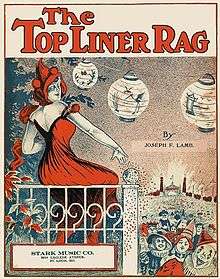Joseph Lamb
_ca._1915.jpg)


Joseph Francis Lamb (December 6, 1887 – September 3, 1960) was a noted American composer of ragtime music. Lamb, of Irish descent, was the only non-African American of the "Big Three" composers of classical ragtime, the other two being Scott Joplin and James Scott. The ragtime of Joseph Lamb ranges from standard popular fare to complex and highly engaging. His use of long phrases was influenced by classical works he had learned from his sister and others while growing up, but his sense of structure was potentially derived from his study of Joplin's piano rags. By the time he added some polish to his later works in the 1950s, Lamb had mastered the classic rag genre in a way that almost no other composer was able to approach at that time, and continued to play it passably as well, as evidenced by at least two separate recordings done in his home.
Life and career
Lamb was born in Montclair, New Jersey. The youngest of four children, he taught himself to play the piano, and was very taken with the early ragtime publications of Scott Joplin. He dropped out of St. Jerome's College in 1904 to work for a dry goods company. In 1907 Lamb was purchasing the latest Joplin and James Scott sheet music in the New York City offices of John Stark & Son when he met his idol Joplin. Joplin was favorably impressed with Lamb's compositions, and recommended him to classical ragtime publisher John Stark. Stark published Lamb's music for the next decade, starting with "Sensation".
Lamb’s twelve rags published by Stark from 1908 to 1919 can be divided into two groups. A) The “heavy” rags which are incorporated with Scott Joplin’s melody–dominated style and James Scott’s expansive use of the keyboard registers. This style of rags includes
- "Ethiopia Rag" (1909)
- "Excelsior Rag" (1909)
- "American Beauty Rag" (1913)
- "Ragtime Nightingale" (1915)
- "The Top Liner Rag" (1916)
B) The “light” rags which have the cakewalk tradition show the narrow-range melodies inspired by Joplin. This style of rags includes
- "Champagne Rag" (1910)
- "Cleopatra Rag" (1915)
- "Reindeer : Ragtime Two Step" (1915)
- "Bohemia Rag" (1919)
- "Contentment Rag" (1915) and "Patricia Rag" (1916) have both characteristics of “heavy” rags and “light” rags.
Lamb’s works show individual stylistic traits. First, he uses sequence for development purposes. Second, he emphasizes on the harmonic sonority of the diminished seventh with upper-neighbor appoggiatura. His contributions to the ragtime literature also show his unique traits. He used a great diversity of texture for all of his rags. In addition, Lamb surpassed ragtime’s usual four-measure phrase structure.[1]
In 1911, Lamb married Henrietta Schultz and moved to Brooklyn, New York. He worked as an arranger for the J. Fred Helf Music Publishing Company and later, starting in April 1914, as an accountant for L. F. Dommerich & Company.
Henrietta died of influenza in 1920, about the same time that popular music interest shifted from ragtime to jazz. Lamb stopped publishing his music, playing and composing only as a hobby. "Bohemia Rag" was the last Lamb rag published before his death in 1960. That same year, his album, Joseph Lamb: A Study in Classic Ragtime, was released by Folkways Records.[2]
With the revival of interest in ragtime in the 1950s, Lamb shared his memories of Joplin and other early ragtime figures with music historians. (Many were surprised to find that not only was he still living, but that he was white.) He also composed some new rags, brought out some of his old compositions that had never been published, and made some recordings.
Lamb died in Brooklyn of a heart attack at age 72.
Unpublished Rags During His Lifetime
Rags that remained unpublished at the time of his death included:
- "Alabama Rag"
- "Alaskan Rag"
- "Arctic Sunset"
- "Bee Hive"
- "Bird-Brain Rag"
- "Blue Grass Rag"
- "Chasin' the Chippies"
- "Chime In"
- "Cinders"
- "Cottontail Rag"
- "Crimson Ramblers"
- "Firefly Rag"
- "Good and Plenty Rag"
- "Greased Lightning"
- "Hot Cinders"
- "Jersey Rag"
- "Joe Lamb's Old Rag"
- "The Old Home Rag"
- "Ragged Rapids Rag"
- "Ragtime Bobolink"
- "Ragtime Special"
- "Rapid Transit Rag"
- "Shootin' the Works"
- "Thoroughbred Rag"
- "Toad Stool Rag"
- "Walper House Rag"
References
- ↑ Hasse, John (1985). Ragtime. Its History, Composers, and Music. New York, N.Y.: Schirmer Books. pp. 245–246. ISBN 0-02-871650-7.
- ↑ Lamb Album Details
- Jasen, David A.; Trebor Jay Tichenor (1978). Rags and Ragtime: A Musical History. New York, NY: Dover Publications, Inc. pp. 122–133. ISBN 0-486-25922-6.
External links
| Wikimedia Commons has media related to Joseph Lamb. |
- Chime In played by Tom Brier on YouTube
- "Patricia Lamb Conn: Connecting with Ragtime's Glory Days" - reminiscences of Lamb's daughter, with family photographs.
- "Perfessor" Bill Edwards plays many Lamb rags, with stories.
- Article: "Joseph Lamb: The Humble Ragtime 'Sensation'" by Ted Tjaden
- Lamb and his compositions on grainger.de
- An episode of A Prairie Home Companion featuring the music of Lamb, with a biography as told by Garrison Keillor
- Joseph F. Lamb - A Passion for Ragtime - biography 2012
- Joseph Lamb at Find a Grave
- Free scores by Joseph Lamb at the International Music Score Library Project